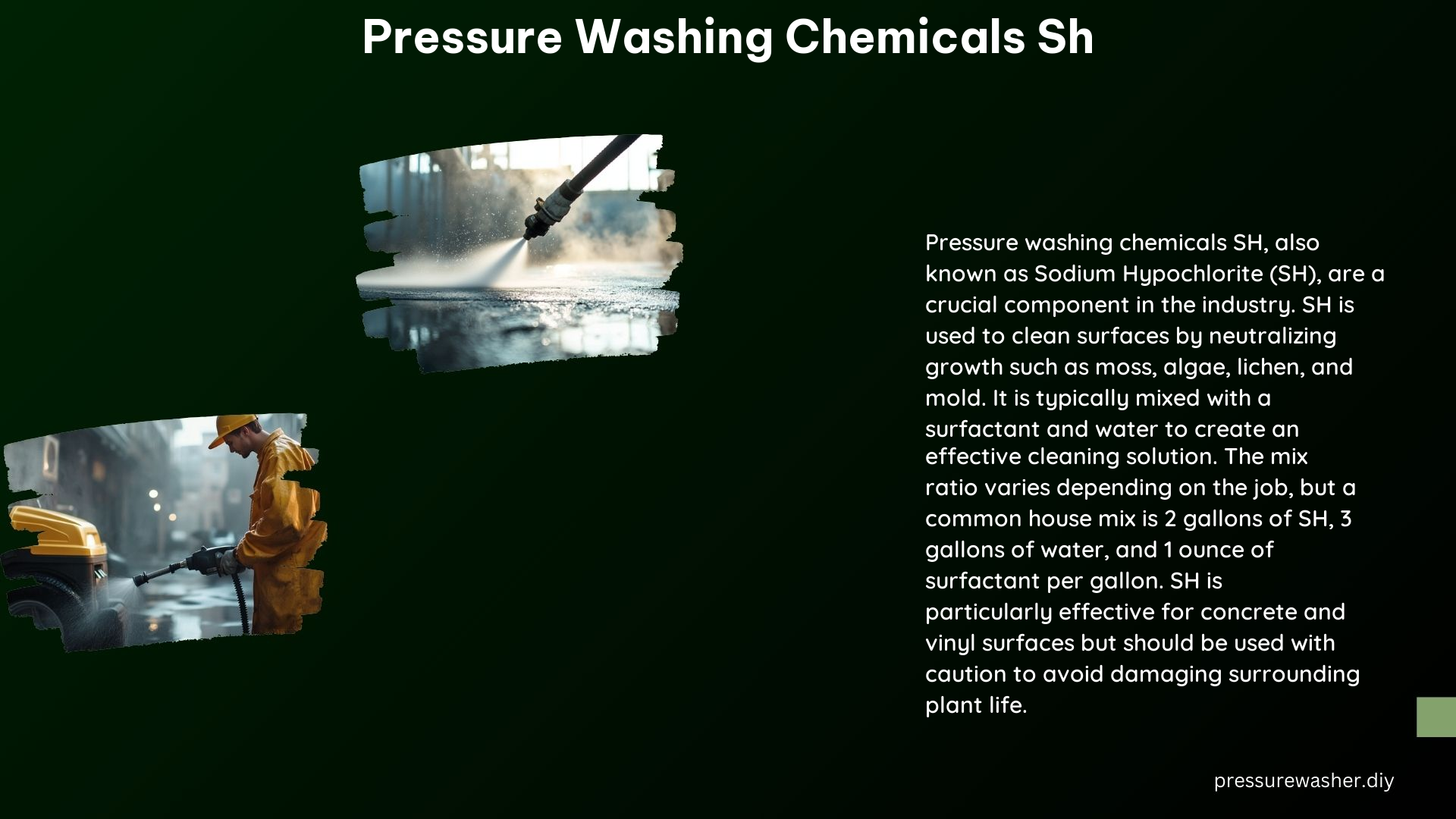Pressure washing chemicals, specifically Sodium Hypochlorite (SH), are a crucial component in the pressure washing industry. SH is a powerful oxidizing agent that effectively removes organic matter, such as mold, mildew, and algae, from various surfaces, making it an essential tool for professional pressure washers and DIY enthusiasts alike.
Ideal Mix Ratio for House Washing
The ideal mix ratio for house washing using SH varies depending on the job and the surface being cleaned. A typical mix includes SH, a surfactant (such as Elemonator), and water. For vinyl jobs, a common mix is 2 gallons of 12.5% SH, 3 gallons of water, and 1 ounce of surfactant per gallon of the mix. This results in a solution with an approximate pH of 12-13, which is effective in breaking down organic matter. For concrete surfaces, a similar mix can be used, but the concentration of SH may need to be adjusted based on the level of soiling and the desired outcome.
It is essential to adjust the mix strength based on the specific job requirements and to ensure proper rinsing to avoid damage to surrounding vegetation. Factors such as surface type, level of soiling, and environmental conditions should all be considered when determining the appropriate mix ratio.
Bleach vs. SH

Sodium Hypochlorite (SH) is often referred to as bleach, but they are not exactly the same. SH is the active ingredient in bleach, but it is more concentrated and corrosive. While both can be used for cleaning, SH is more effective for killing organic growth like moss, algae, and mold. Bleach, on the other hand, is more commonly used for general cleaning and disinfecting.
The key difference between SH and bleach is the concentration of the active ingredient. Household bleach typically contains 5-6% SH, while commercial-grade SH used in pressure washing can range from 10% to 12.5% concentration. This higher concentration makes SH more potent and effective for removing stubborn organic stains and growth, but it also requires greater caution and proper handling.
Mixing SH with Water and Surfactant
To properly mix SH with water and a surfactant, follow these steps:
- Start with a base mix: Begin with a 50% SH (12.5% concentration) and 50% water mix, then adjust as needed.
- Add surfactant: Use 1 ounce of surfactant (like Elemonator) per gallon of the mix. The surfactant helps to improve the wetting and penetration of the solution, enhancing its cleaning effectiveness.
- Adjust the mix: Based on the job requirements, adjust the mix strength by adding more SH or water. For heavily soiled surfaces, you may want to increase the SH concentration to 60-70%, while for lighter cleaning, a 40-50% SH mix may be sufficient.
- Rinse thoroughly: Ensure proper rinsing to avoid damage to surrounding vegetation. The rinse water should be clear and free of any residual chemicals.
It’s important to note that the specific mix ratio may need to be adjusted based on the surface type, level of soiling, and environmental conditions. Always perform a small-scale test in an inconspicuous area to ensure the desired results before applying the solution to the entire surface.
Technical Specifications
Sodium Hypochlorite (SH) is available in various concentrations, typically ranging from 10% to 12.5%. The higher the concentration, the more potent and effective the solution will be for cleaning and disinfecting. However, it is essential to handle SH with care, as it is a corrosive and hazardous chemical that requires proper personal protective equipment (PPE) and safety precautions.
When working with SH, it’s crucial to wear the appropriate PPE, including chemical-resistant gloves, goggles, and a face shield. Ensure adequate ventilation and avoid mixing SH with other chemicals, as this can result in the release of toxic gases. Additionally, it’s essential to properly store and dispose of SH in accordance with local regulations.
Additional Tips
- Wet surrounding vegetation: Always wet surrounding vegetation before, during, and after using SH to prevent damage. This helps to dilute and rinse away any overspray or runoff.
- Use appropriate application methods: Utilize a pump sprayer or a soft wash system to apply the SH mix effectively, ensuring even coverage and minimizing the risk of damage.
- Consider a blend manifold: Using a blend manifold can help to accurately mix the SH, water, and surfactant, ensuring a consistent and reliable solution.
- Avoid mixing SH with acid: For rust removal, use a different chemical like F9 Bark, as mixing SH with acid can be dangerous and result in the release of toxic chlorine gas.
- Perform regular equipment maintenance: Regularly clean and maintain your pressure washing equipment to ensure optimal performance and longevity.
By following these guidelines and best practices, you can effectively and safely utilize Sodium Hypochlorite (SH) in your pressure washing operations, delivering exceptional results while minimizing the risk of damage or environmental impact.
References
- CleanProSupply. (2022). Proper Application of SH+H2O+Surfactant on a Professional Pressure Washing Jobsite. Retrieved from https://www.cleanprosupply.com/educational-blog/proper-application-of-shh2osurfactant-on-a-professional-pressure-washing-jobsite/?srsltid=AfmBOooc6ZlC0-LiyBUCRuGLRbTAXrjl0K_9jhiabMXgtxPAujJdTM5S
- DirtKiller. (n.d.). 15 Gallon Drum – Sodium Hypochlorite – SH – Bleach. Retrieved from https://www.dirtkiller.com/shop/8100127-15-gallon-chemical-bleach-sodium-hypochlorite-12-5-8245?srsltid=AfmBOorMy0AX8GwKJ7UJqwr6qngDIz9ppjhCqP7Ic7y6SdTJCYJ5d-Q0
- The Wash Nerds. (2023). Beginner Guide To SH For Pressure Washing. Retrieved from https://www.youtube.com/watch?v=ibRF1ujKYl4
- Pressure Washing Resource. (2017). What is the Mix Ratio of SH for House Wash? Retrieved from https://pressurewashingresource.com/community/t/what-is-the-mix-ratio-of-sh-for-house-wash/9120
- Reddit. (2020). SH mix questions. Retrieved from https://www.reddit.com/r/pressurewashing/comments/iz6kt5/sh_mix_questions/
